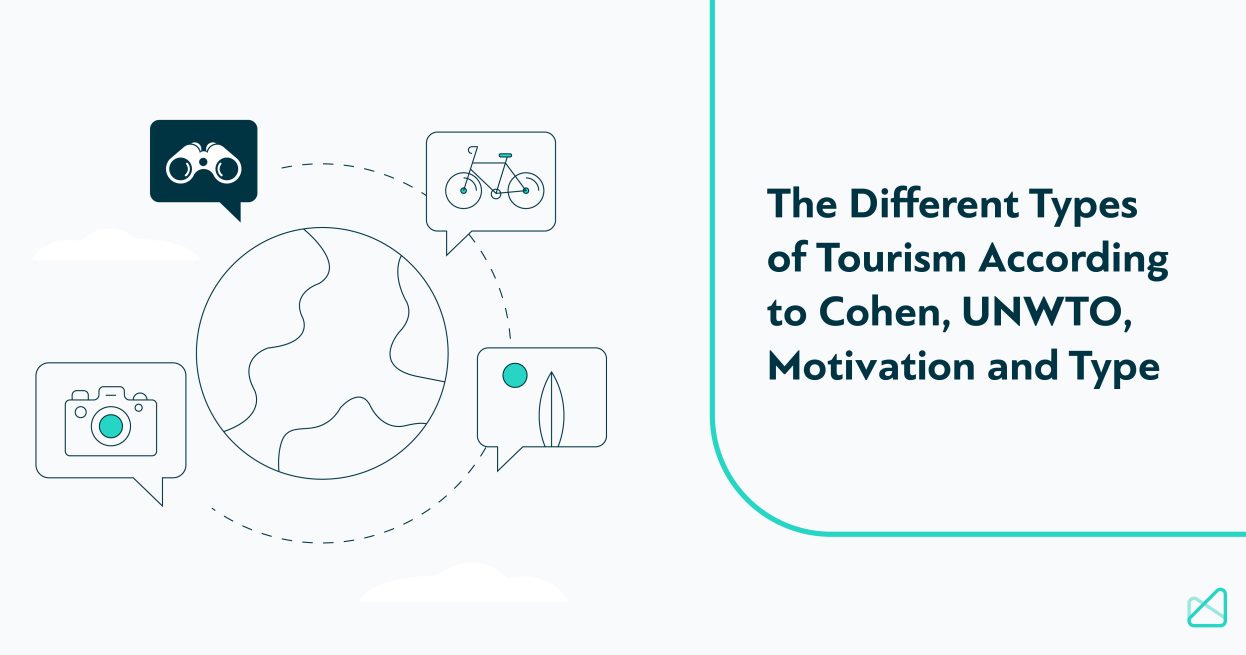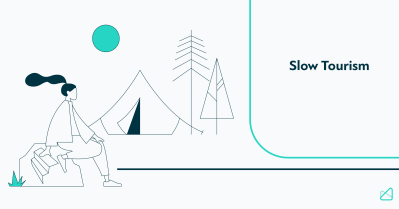The different types of Tourism according to Cohen, UNWTO, motivation and type

The Tourism industry has a direct impact on the global economy. In 2019 alone, 1.4 billion international arrivals were recorded, which is equivalent to one-fifth of the world’s population.
Due to the number of components that play an active role in tourism, there are an infinite number of criteria that can be used to classify it. In this article we will share what we consider to be the most significant of these criteria.
Types of Tourism according to the UNWTO
The World Tourism Organization defines three basic types of tourism in its glossary:
- Domestic Tourism: these are the activities carried out by a person within their country of residence as part of a touristic trip.
- Inbound Tourism: carried out by a non-resident tourist in the destination as part of a touristic trip.
- Outbound Tourism: tourism activities undertaken outside the country of residence.
These types can be combined with each other to give rise to other categories:
- Internal Tourism: combines domestic and inbound tourism, as it encompasses the activities that both foreigners and nationals undertake within the borders of a country.
- National Tourism: Combines domestic and outbound tourism, as it involves trips made by residents of the same country both within and outside its borders.
- International Tourism: carried out both by residents outside their country of residence (outbound) and by foreigners within the borders (inbound).
Beyond this categorization, there is a sociological approach, in which Erik Cohen, sociologist and winner of the UNWTO Ulysses Prize for his contribution to the knowledge of tourism, defines different types of tourism associated with the organization of the trip, as well as the nature of the interaction with the destinations.
Types of tourism according to Cohen:
Institutionalized
- Individual mass: this is the tourist who goes to an agency in search of a tourist package. They make individual trips, taking advantage of the destination’s infrastructure established for mass tourism.
- Organized mass: these travelers take organized tours where all the details are covered and there are no surprises of any kind. It is usually family tourism without any major variations.
Non-institutionalized
- Drifter: this is the independent tourist who backpacks. They do not depend on the infrastructure and have little influence on the destination, as they interact with the environment and usually integrate with it.
- Explorer: This is the tourist who seeks new experiences, often extreme. The definition they use is “off the beaten track.” They prioritize the experience and can sacrifice comforts.
Cohen also proposes a division based on the importance of travel in people’s lives. There are five types of experience:
- Fun or recreational tourism
- Distraction tourism
- Experiential tourism
- Experimental tourism
- Existential tourism
Types of tourism according to motivation
Valene Smith, a key figure in the Anthropology of Tourism, defines in her introduction to “Host and Guest” the following types of tourism, according to the motivation of the trip:
- Recreational
- Cultural
- Ethnic
- Environmental
- Historical
And later she expands the classification according to Tourist types, where she describes:
Explorers
They engage with the destination environment and are willing to adapt their behavior to the environment. They choose to visit less-traveled places and do not want to be seen as tourists.
Elite tourists
They also travel in small groups and adapt to local life, but for a limited time. They demand more amenities.
Off-beat tourists
These are independent tourists who break away from traditional itineraries and are looking to see new places. They use guidebooks for tips.
Unusual tourists
They travel on package tours or tours to visit indigenous communities. Their interest in local cultures is contemplative, and they demand the comforts of modern life so as not to take risks in the exchange.
Incipient mass tourists
Although not large in volume, these groups are beginning to demand infrastructure in the destinations they visit.
Mass tourists
They do not forgo the comforts of their country of origin and expect to be served in their own language.
Charter tourists
They purchase tours for short periods of time, demand high-quality services and have almost no interaction with the local environment.
There are infinite approaches and classifications for tourism around the world. A study by the Inter-American University for Development (UNID) makes an interesting distinction between “Classification” and “Typology” in which it defines eight kinds of tourism according to their form, which can, in turn, be subdivided into types.
Types of tourism according to type and purpose of the trip
Beyond these broad approaches, there is a series of categories approved by the UNWTO that is defined by the destination and purpose of the trip, and can be summarized as follows:
Rural Tourism
This takes place in destinations with low population density where agriculture and forestry are prevalent. The main objective is to experience nature, culture and productive activities.
Examples
- Angling tourism
- Observation tourism
Ecotourism
The core element is responsible contact with the natural environment, where the tourist observes and carries out activities in the open air.
Examples
- Bird watching
- Observation of autochthonous species
Adventure tourism
Tourism in contact with nature, involving physical dexterity to undertake activities that are generally carried out in the open air.
Examples
- Climbing
- Zip-lining
- Scuba diving
- Trekking
- Sport fishing
Cultural Tourism
This takes place in destinations that have a remarkable cultural heritage and preserve its value. The objective is to discover and enjoy these values and traditions.
Examples
- Field trips
- Artistic performances
- Festivals or other cultural events
- Visits to sites and monuments
- Folklore
- Art
- Pilgrimage
Business Tourism
Regardless of the destination, the reason for the trip is business or professionally motivated. This type of tourism entails a specific approach, as it is carried out by demanding travelers, with little time and particular needs.
Examples
- Attending conferences and congresses
- Attending Trade Fairs and Exhibitions
- Other professional and business reasons
Gastronomic Tourism
The trip must involve culinary experiences in the destination, which can range from enjoying a meal to learning how to cook.
UNWTO notes the high potential of this category as a sustainable activity to boost the development of local economies and promote inclusiveness.
A growing trend worth highlighting is Wine Tourism.
Coastal, Maritime and Inland Water Tourism
Includes all water-related activities. The most prominent category is Sun and Beach Tourism. However, the following should not be overlooked:
- Cruises
- Inland river navigation
Urban Tourism
This tourism takes place in a non-agricultural economic environment. Urban destinations offer a wealth of experiences related to art, architecture, commerce, social activities and good transport connectivity
Health tourism
Relates to the physical, mental or spiritual health benefit that travel can offer, provided by specific activities.
Examples
- Medical tourism
- Wellness tourism
- Spiritual tourism
Mountain Tourism
The nature of the trip is determined by the relief of the destination. It is not related to adventure sports, but to enjoying the attributes of the environment.
Educational Tourism
The objective is focused on acquiring new skills and knowledge.
Examples
- Exchange trips
- Language courses
- Tours for school groups
Sports Tourism
This is aimed at those who are going to enjoy or watch a sporting activity.
Examples
- Ski Trips
- Attending the Football World Cup
- Attending the Olympic Games
- Sports Delegation Trips
Each category will also be defined according to the needs and possibilities offered by the tourist destination, but in principle it is important to be able to sustain a basic classification in order to guide the statistics and to be able to work on comparisons and equivalences, depending on the focus we are addressing.
Bibliography
Erik Cohen, Major trends in contemporary tourism. Department of Sociology and Anthropology. The Hebrew University of Jerusalem, 2004
Erik Cohen, The sociology of tourism: Approaches, issues and findings. in Annual Review of Sociology, 10,373-392., 1984
Smith, Valene, Hosts and guests. The anthropology of tourism. Philadelphia, University of Pennsylvania Press, 1989.
Subscribe to
our newsletter
Yay! You are now
subscribed to our
newsletter
Mize is the leading hotel booking optimization solution in the world. With over 170 partners using our fintech products, Mize creates new extra profit for the hotel booking industry using its fully automated proprietary technology and has generated hundreds of millions of dollars in revenue across its suite of products for its partners. Mize was founded in 2016 with its headquarters in Tel Aviv and offices worldwide.
Related Posts

30 Most Important Travel Industry Events for 2024
30 min. Social share: 2024 is packed with must-attend travel industry events. Stop by to discover all relevant events conveniently grouped by continents with listed dates, themes, and locations! Many travel industry experts believe that travel industry events play a pivotal role in shaping the future of the travel industry. Why is this so? It’s […]

Empowering Equality: Mize Leads the Way in Travel Technology
7 min. Are we all equal? Are we all equally represented in the business world? In some professional sectors, there might still be some under-representation of women, minorities, and the LGBTQIA+ community. The tech sphere is no different, but is the travel tech sector a spark of hope? As the business world becomes more diverse, […]

Slow Tourism Case Studies: Examples to Truly Understand Slow Tourism
14 min. The tourism industry is moving at an ever-accelerating pace. That’s because the tourism industry is perhaps one of the verticals that depend on the most factors. One of the main factors that affect it is social movements, given that tourism brands of all sizes always cater to the needs of consumers. One of […]